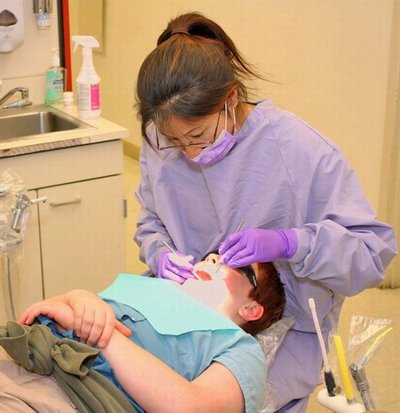December 10, 2009
UW faculty members help lead children’s oral health campaign
With UW School of Dentistry faculty member Dr. Wendy Mouradian helping to lead the way, the nation’s pediatric health care community has taken the next major step in a campaign to promote children’s oral health.
Academic Pediatrics, the journal of the Academic Pediatric Association, has published a Special Issue on Children’s Oral Health, featuring commentaries from leading oral health figures as well as from Dr. David Satcher, Surgeon General of the United States from 1998 to 2002.
The volume is an outgrowth of a landmark national summit on children’s oral health, convened by the American Academy of Pediatrics (AAP) in Chicago in November 2008. That event was co-chaired by Mouradian, associate dean for regional affairs and curriculum at the School of Dentistry. A pediatrician by training, she also holds appointments as professor of pediatric dentistry, pediatrics, and health dervices at the UW. She chaired the 2000 Surgeon General’s Conference on Children and Oral Health. Previously she was director of the Craniofacial Program at Seattle Children’s.
The special issue represents a ‘‘midterm examination” of how far the United States has come since a 2000 report by the Surgeon General in meeting the federal government’s Healthy People 2010 oral health objectives and other important recommendations. Key findings include these:
- Oral disease, primarily dental caries (tooth decay), is the most common pediatric disease and can lead to physical and psychological disabilities as well as significant morbidity in adulthood.
- Recent data suggest that this preventable disease is increasing among very young children.
- Children’s diets, a subject of growing concern for obesity, can also increase dental caries.
- Scientific and technological advances in sequencing of the human genome, tissue. engineering and saliva diagnostics may have significant potential to affect oral health.
- Pediatricians, despite believing oral health is important, do not address oral health issues for most of their young patients, according to a recent AAP Periodic Survey of Fellows.
In the special issue, Mouradian and her co-authors call for “dentists, physicians and other health professionals who work with children to embrace a shared responsibility for children’s oral health and work to overcome the historic separation between dentistry and medicine.”
“We hope these papers will strengthen your commitment to advancing this important area of children’s health,” Mouradian tells readers. “It is up to all of us.” Satcher renews his call to improve children’s oral health, recalling the recent deaths of several children from dental caries as evidence of “the gap between what we know and what we do.”
The issue features contributions from experts in dentistry, medicine, nursing, and public policy and urges health-care professionals to make oral health a pediatric priority. Most of the featured papers in the issue were presented a year ago at the AAP oral health summit. Guest editors for the special issue were Mouradian and Dr. Rebecca L. Slayton, chair of the Department of Pediatric Dentistry at the University of Iowa and a former faculty member in the UW Department of Pediatric Dentistry.
One key contributor to the special issue is Dr. Charlotte W. Lewis, associate professor of pediatrics at the UW School of Medicine, who also holds an adjunct appointment in the UW Department of Pediatric Dentistry. In addition to the analysis of the AAP’s Periodic Survey of Fellows’ office practices in oral health — which suggests that pediatricians have made only modest progress in engaging oral health in the last decade — Lewis summarizes national data on access to dental care for children with special health care needs.
Also contributing to the special issue are Dr. Susan Coldwell, associate dean for student life and admissions at the School of Dentistry, and Dr. Peter Milgrom, director of the School of Dentistry’s Northwest/Alaska Center for Research on Oral Health Disparities.
In his commentary, Editor-in-Chief Peter G. Szilagyi, of the University of Rochester Medical Center, asks, “Why should Academic Pediatrics devote an entire issue to children’s oral health now?” He answers: “First, oral health is health, and children’s oral health is part of pediatrics. … Second, we are far from achieving our Healthy People 2010 oral health objectives in reducing the prevalence of caries in children. … Third, substantial disparities exist in children’s oral health and access to care. … Fourth, oral health represents an excellent paradigm in which the traditional pediatric community needs to work more closely with other health professionals — in this case dental professionals — to advance the health of children.”
Also writing special commentaries are Slayton and Dr. Harold Slavkin, former director of the National Institute of Dental and Craniofacial Research.
Other issues considered in this volume of Academic Pediatrics are access to dental care for children, and ethical and policy issues in the care of children with craniofacial conditions, including quality of life, costs of care, and prenatal diagnosis of craniofacial defects.
In other articles, authors review the current oral health workforce, including new models of mid-level dental practitioners, and stress the need to better educate both dentists (especially general and pediatric dentists) and primary care medical providers (pediatricians, family physicians, nurse practitioners and physicians’ assistants) to promote pediatric oral health and ensure that children have adequate access to dental care.
Articles also discuss the effect on children’s oral health from government actions and policy decisions, such as the Children’s Health Insurance Program, review other progress at state and national levels to promote children’s oral health, and identify key policy steps for the future.

